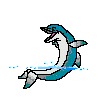
 TOUCH
THE SEA® TOUCH
THE SEA®
Environmental
|
 |
This
section of the Touch the Sea website began in response to a recently-published
children’s book entitled
Where Do Balloons Go?
by Jamie Lee Curtis.
Let’s see what good we can do.
The word needs
to get out on the danger of balloons, and Jamie Lee Curtis’ book
Where Do Balloons Go? (isbn#0-06-027980-X,
isbn#0- 06-027981-8) proves it. The book is a nice exercise of the
imagination ("Do they ever get married and make balloon heirs?")
but never answers its title question except imaginatively. It doesn’t
specifically encourage kids to release balloons, but neither does
it deal with the consequences of balloon releases. The Caribbean Conservation
Corporation, on their website (http://www.cccturtle.org/involved.htm),
cites one consequence: "Sea turtles mistakenly eat the balloons
and die." Whales also mistakenly eat balloons and die —
one scientist who studied such a case was with the Marine Mammal Stranding
Center in Brigantine, N. J.
I’m hoping Ms. Curtis will be willing to publish — and publicize -- the reality on balloon releases. I’ve sent the publisher, Joanna Cotler Books (An Imprint of Harper Collins Publishers www.harperchildrens.com) an e-mail and Harper Collins a hard copy letter to that effect. They instruct those who wish to write to their authors to do so to the
Author’s Name
c/o Author Mail, 7th floor
Harper Collins Publishers
10 East 53rd St.
New York, NY 10022
in case you’d like to offer feedback.
Before I could do any of these things I needed to write "What Happens to Balloons?", which appears below, along with copies of my letters to Ms. Curtis and Harper Collins.
Any support you can give animals everywhere in this issue will be greatly appreciated.
Best regards,
Dee Scarr (dee@touchthesea.com)
 |
What
Happens to Balloons?
by Dee Scarr
(a response
to Where Do Balloons Go?)
| What happens to balloons when people "free" them? They float higher and higher ‘til we can’t even see them. but… Just because we can’t see them doesn’t mean they’re not there. Every balloon that goes up, comes down some time, some where. Some leak their filling and drift down, down, down. We find them in forests, and parks, and playgrounds. Some keep on floating, ‘til the air gets so cold that they break into pieces that fall on trees, lakes, and roads. Those balloons that are "freed" don’t deserve to be booed. They have no way of knowing they’ll be treated as FOOD. But deer, birds, and rabbits out looking for munches will nibble balloon bits -- which are DANGEROUS lunches. The balloons or their pieces that fall to the sea look so much like jellyfish they’re eaten with glee. But balloons are not jellyfish. They are NOT good to eat. So some turtles and whales give their lives for our treat. What happens to balloons when they’re released in the air? They hurt themselves and our planet And we who live here. So hold tight to balloons; it’s the best thing to do. And the Earth will be healthier all thanks to YOU. |
 |
*my letter to Harper Collins*
1 November 2000
President
Harper Collins Publishers
Dear Madam or Sir:
Jamie Lee Curtis is great. My appreciation of her as a celebrity makes me that much more frustrated that the word about the danger of balloons has not reached her — and ‘way too many other people.
I loved the flights of fancy in Where Do Balloons Go?, but the reality of released balloons is too sobering for it to be ignored. Balloons eventually get back to earth, either whole or in pieces. The Caribbean Conservation Corporation, on their website (http://cccturtle.org/involved.htm) baldly states one consequence of returns, when the balloons end up in the sea: "Sea turtles mistakenly eat the balloons and die." A scientist who studied one whale who died from mistaken balloon ingestion is with the Marine Mammal Stranding Center, in Brigantine, N.J. (http://www.mmsc.org/).
Every single species of sea turtle is endangered or threatened.
Harper-Collins and Ms. Curtis could do a great good deed — for the planet -- by publishing the factual answer to Where Do Balloons Go? and helping people understand that the fun of balloons is in keeping them around, not in letting them go.
I sent e-mails to your website in September, and a hard-copy letter (copy enclosed) to Ms. Curtis on 30 September. I’ve received no responses.
Please, get involved!
Best regards,
Dee Scarr
*my letter to Jamie Lee Curtis*
3 October 2000
Dear Ms. Curtis:
I’ve always enjoyed and respected you and your work. Whenever I see your smile it makes me feel good.
My life’s focus has been the oceans and the creatures who inhabit them, so I’ve been hearing about balloons for years. The fact that you haven’t heard how balloons can hurt wildlife is a testimony to the fact that environmentalists — myself included — have failed to educate people about balloons.
Released balloons return to earth eventually, either whole or in pieces. Animals eat them. They’re believed to have caused or led to the deaths of marine turtles and at least one whale.
Ms. Curtis, I know that your book doesn’t encourage people to release balloons, but Where Do Balloons Go? has put you into a fantastic position to help animals worldwide, by adding the true answer to your question in addition to the imaginative one. I think this could be done in a way that would give you greatly favorable publicity (well, except possibly from the balloon industry), too.
You won’t want to take just my word for this. Any environmental agency can confirm the dangers of balloons to wildlife, but the one whose website mentions it is the Caribbean Conservation Corporation, at http://www.cccturtle.org/involved.htm: "Helium-filled balloons are frequently released into the sky to celebrate events. Like plastic trash, helium balloons end up in the ocean, especially when released near the coast. Sea turtles mistakenly eat the balloons and die." The scientist who studied the whale who died from balloon ingestion was with the Marine Mammal Stranding Center, in Brigantine, N.J. (http://www.mmsc.org/).
One way I dealt with my balloon-release distress was to write a version of the true answer to the question. I hope you enjoy it.
Best regards,
Dee Scarr, Touch The Sea
 |

Naked Camera Event
|